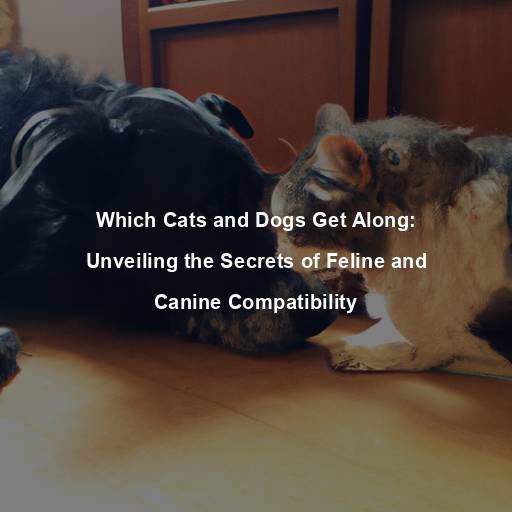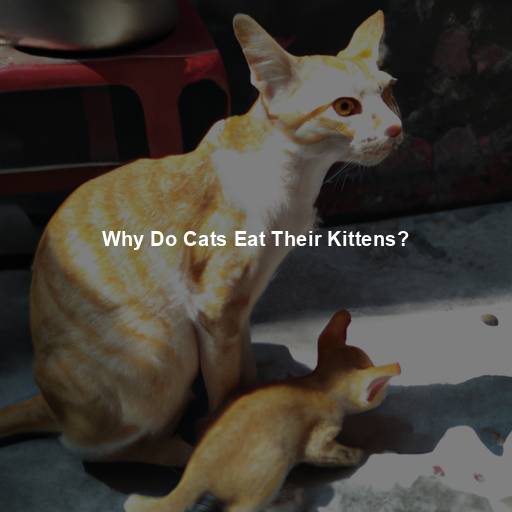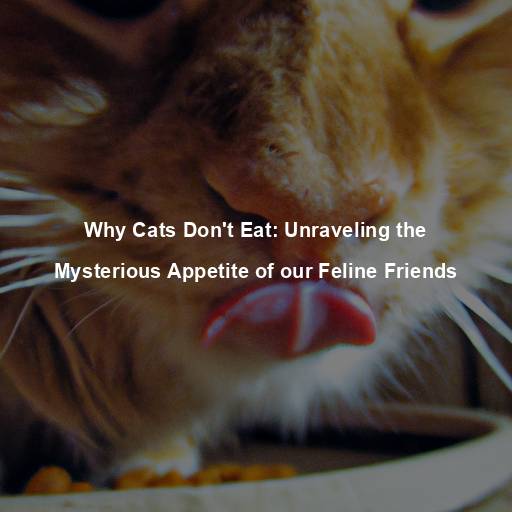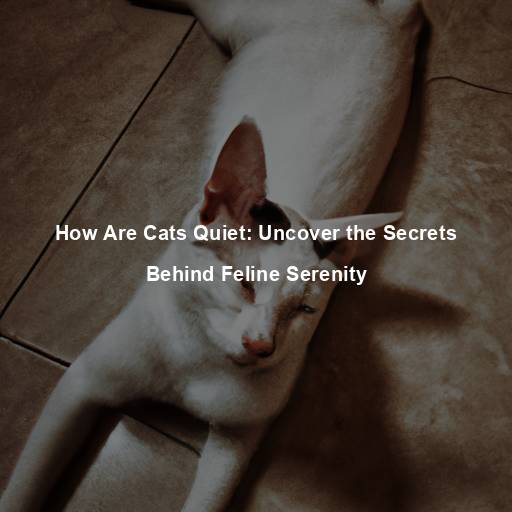Which Cats and Dogs Get Along: Unveiling the Secrets of Feline and Canine Compatibility
Last Updated on July 9, 2023 by Evan
Take it slow when introducing your furry friends! Start by organizing short, supervised meet-ups between your cat and dog, gradually extending the duration as they grow more at ease with each other’s company. The key here is patience and observation, ensuring their interactions are positive and stress-free.
When it comes to building a solid bond between your feline and canine companions, positive reinforcement is key. By showering them with tasty treats, heartfelt praise, and affectionate gestures, you’re sending a clear message that their interactions are valued and cherished. This delightful approach not only sparks joy but also cultivates an atmosphere of togetherness and tranquility, leaving both furry friends feeling content and appreciated.
When bringing a new furry friend into your home, it’s crucial to honor the boundaries of both your cat and dog. By respecting their personal space and taking note of any signs of stress or discomfort, you can ensure a smooth introduction process. If either pet seems overwhelmed, it’s best to give them the time and space they need to acclimate before attempting another introduction.
- Avoid Forcing Interactions: Forcing interactions between a cat and dog can lead to negative associations and potentially harm the relationship. Instead, allow them to approach each other at their own pace, always supervising their interactions and providing support if needed.
Contents [hide]
- 1 Building Trust and Encouraging Bonding
- 2 Monitoring and Nurturing the Relationship
- 3 Celebrating Feline and Canine Companionship
- 4 FAQs: Which Cats and Dogs Get Along
- 4.1 What types of cats get along well with dogs?
- 4.2 What factors should I consider when introducing a new cat to a dog?
- 4.3 Can certain dog breeds better coexist with cats?
- 4.4 How can I encourage positive interactions between my cat and dog?
- 4.5 What signs indicate that my cat and dog are getting along?
Building Trust and Encouraging Bonding
Building a Positive Association
Creating a positive association between cats and dogs is vital for building trust and encouraging bonding. Here are some strategies to help foster a positive relationship:
One intriguing aspect of introducing a new cat and dog to each other is the process of scent exchange. By swapping bedding or toys between the two animals, we can create a sense of familiarity and curiosity in their minds. This can be done by strategically placing these items in their designated living areas, or by gently rubbing a soft cloth on one animal and allowing the other to encounter and explore its aromatic secrets.
Create a harmonious atmosphere for your feline and canine companions by inspiring positive experiences. Foster an enchanting bond through engaging activities that tickle their shared interests. Indulge in interactive playtime, shower them with gentle caresses, or tantalize their taste buds with delectable treats while they bask in each other’s company.
- Parallel Activities: Engage both the cat and dog in parallel activities, such as interactive toys or feeding puzzles, in the same room. This allows them to enjoy each other’s company without direct interaction, gradually building familiarity and comfort.
Training and Socialization
Training plays a crucial role in establishing boundaries and teaching appropriate behaviors to both cats and dogs. Positive reinforcement training methods can help shape their behavior and encourage cooperative interactions. Additionally, exposing both cats and dogs to various socialization experiences from a young age can enhance their adaptability and ease their acceptance of new companions.
Monitoring and Nurturing the Relationship
Ongoing Observations
After successfully integrating our furry feline friends with their canine companions, it’s imperative to stay vigilant and keep a close eye on their ongoing dynamics. Continuously observing their behavior and interactions serves as a crucial tool in promptly addressing any signs of discomfort or looming problems. Here’s a rundown of essential points to bear in mind as you navigate this fascinating journey of feline and canine coexistence:
- Body Language: Understanding the body language of both cats and dogs is crucial in deciphering their communication. Signs of stress or aggression, such as raised fur, hissing, growling, or excessive barking, should be addressed promptly.
It’s no secret that cats and dogs have their differences, from their meows to their barks. But did you ever consider the importance of giving them separate time and space? By providing these furry friends with their own designated areas, you’re setting the stage for a harmonious household where they can recharge and have independent experiences. This not only reduces the potential for conflicts but also ensures that their unique needs are being met.
Seeking Professional Assistance
In some cases, despite all efforts, cats and dogs may struggle to establish a harmonious relationship. If conflicts persist or escalate, seeking professional assistance from a qualified animal behaviorist or trainer is recommended. These experts can assess the situation, provide tailored advice, and develop a customized plan to address specific challenges.
Celebrating Feline and Canine Companionship
The Joy of Feline and Canine Bonds
There is a mystical aura surrounding the unbreakable bond between cats and dogs, a bond that captivates the hearts of humans and animals alike. Behold the enchanting dance of their playful interactions, the harmonious symphony of their shared naps, and the comforting embrace of their presence. A profound understanding of the complexities within the feline and canine world fuels the magic, as we embark on a journey to cultivate the perfect companionship. With patient introductions, a nurturing environment, and a sprinkle of fate, we bear witness to the extraordinary connection that unites cats and dogs in an inexplicable tapestry of harmony and intrigue.
A Testament to Love and Acceptance
Witnessing the incredible bond between cats and dogs, it’s a powerful reminder of the transformative power of acceptance and connection in the animal kingdom. As caretakers and admirers of our furry friends, it is our duty to cultivate an atmosphere of empathy, perseverance, and kindness. Embarking on the adventure of feline and canine camaraderie unveils a mosaic of joyous instances and steadfast affection that leaves us in awe.
FAQs: Which Cats and Dogs Get Along
What types of cats get along well with dogs?
When it comes to cats and dogs coexisting in perfect harmony, we must look beyond stereotypes and recognize the unique personality traits of each feline. While certain breeds may have a reputation for being more sociable, it is crucial to assess the individual cat’s temperament. Cats with calm and friendly dispositions are generally more open to living alongside their canine counterparts. Furthermore, early exposure to dogs or positive previous interactions can greatly influence a cat’s ability to get along with dogs. However, it is paramount to remember that every cat possesses their own idiosyncrasies, and their compatibility with dogs can be a puzzle waiting to be solved.
What factors should I consider when introducing a new cat to a dog?
Introducing a new cat to a dog should be done gradually and cautiously to ensure a smooth transition. Firstly, consider the age and temperament of both the cat and the dog. It’s generally easier to introduce a kitten to a dog or a calm adult cat to a well-behaved and tolerant dog. Make sure to provide separate spaces for the cat and dog initially, gradually allowing them supervised interactions in a controlled environment. Ensure that both animals have plenty of their own resources, such as litter boxes, food bowls, and resting areas, to avoid potential conflicts. Patience and positive reinforcement play a vital role in creating a positive association between the cat and dog during the introduction process.
Can certain dog breeds better coexist with cats?
While breed can be a general indicator of certain traits, it doesn’t guarantee that one breed will get along better with cats than another. However, some dog breeds are known for their generally calm and laid-back demeanor, which can increase the likelihood of successful coexistence with cats. Breeds, such as Golden Retrievers, Labrador Retrievers, Beagles, Cavalier King Charles Spaniels, and Basset Hounds, often exhibit friendly and gentle characteristics that may be more compatible with cats. Nevertheless, it’s important to assess the individual dog’s temperament, training, and previous experiences, as these factors greatly influence their compatibility with cats.
How can I encourage positive interactions between my cat and dog?
To develop positive interactions between your cat and dog, it’s essential to create a safe and comfortable environment for both pets. Start by allowing them to explore each other’s scents by swapping their bedding or using pheromone products designed to provide a calming effect. Gradually introduce them to one another through short and supervised meetings, rewarding calm and friendly behavior from both sides. Offer treats and praise whenever they display positive interactions, such as sniffing or gentle play. Always provide each pet with their own space to retreat when they need alone time. With time, patience, and a consistent routine, your cat and dog can form a bond based on trust and companionship.
What signs indicate that my cat and dog are getting along?
It’s truly a wonder when our furry companions form a bond, and there are certain telltale signs that can assure us that our cat and dog are on the path to a harmonious relationship. A most promising sign is the willingness of both pets to approach one another with no hint of fear, aggression, or dominating tendencies. Furthermore, if they find comfort in peacefully cohabiting the same space, snooze or relax in each other’s presence, groom each other, or engage in gentle play, it’s an encouraging sign of their blossoming connection. However, it’s worth keeping in mind that even in the best of relationships, occasional squabbles or disagreements may perplex us, but don’t fret, as it’s all part of the norm.






